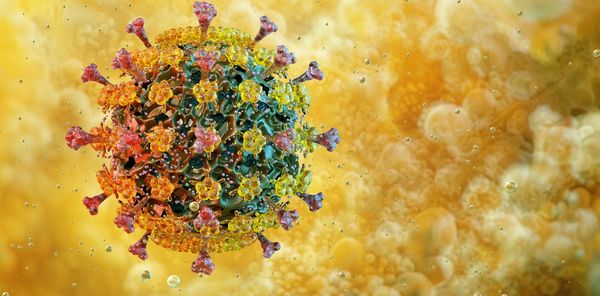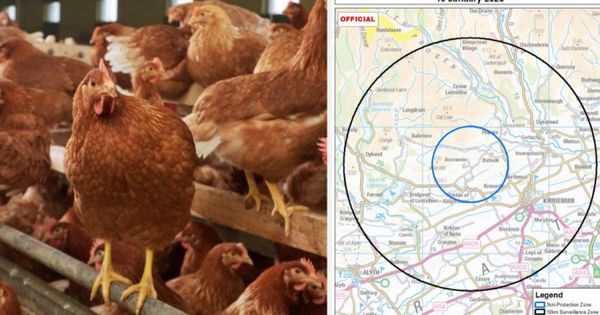
Last month, researchers published a report in the New England Journal of Medicine (NEJM) detailing how a 13-year-old in Canada fought for her life after contracting a severe bird flu infection from an unknown source. In addition to going on life support with an ECMO machine, the teenager received a plasma exchange and multiple antiviral treatments. But her case didn’t initially start severe. Her symptoms began with double conjunctivitis, also known as pink eye, and turned into a fever and coughing. When she first went to the hospital she tested positive for influenza A — but not the seasonal subtype. Further testing suggested she had a high viral load of a novel influenza A infection, which researchers eventually discovered to be avian flu caused by the H5N1 virus.
As the Centers for Disease Control and Prevention (CDC) explains, bird flu is a disease caused by the influenza A virus. At the same time, recent CDC data shows that seasonal influenza A is rising across the U.S. — specifically the H1N1 (swine flu) and H3N2 strains. While it may just seem like a tiny change in numbers, these differences in flu viruses can mean they are more pathogenic and deadly. But how do researchers know that if a person tests positive for influenza A, it’s not H5N1 avian flu?
“We don’t have the ability to differentiate through quick, antigen tests at this time,” Katelyn Jetelina, an epidemiologist and author of the newsletter Your Local Epidemiologist, told Salon. “So, in other words, we don’t know.”
Jetelina elaborated that when it comes to rapidly discerning whether or not a person is infected with H5N1, or another type of flu A, people are reliant on clinicians to decide whether or not further testing is necessary. This is usually triggered by symptoms — like red eyes for H5N1 or a history of having exposure to sick animals. According to the CDC, 66 humans have been infected with H5N1 in the last year. On Friday, the San Francisco Department of Public Health reported a presumptive case of H5N1 bird flu in a child, which the CDC hasn't confirmed yet. The patient experienced symptoms of fever and conjunctivitis but did not require hospitalization and have since fully recovered.
While a majority of those cases occurred from contact with infected poultry or dairy herds, two sources of infected cases remain unclear. To date, most cases haven’t been severe. But last week the CDC reported the first bird flu death in the United States.
Amesh Adalja, an infectious disease and senior scholar at Johns Hopkins Center for Health Security, told Salon H5N1 and other avian influenza viruses are a type A influenza virus.
“Many people, when they are formally diagnosed with influenza, undergo rapid antigen testing that just differentiates between influenza A and influenza B,” he said. “If a person has a laboratory-based PCR test done for influenza and an influenza A virus is detected, the virus is subtyped to determine if it is an H1 or H3 or untypeable.”
Tests are submitted to the CDC for confirmation. According to the agency, over 77,000 specimens have been tested that could have been H5N1, and only three have been detected through national testing since February 25, 2024. Notably, it is not uncommon for flu A to be the more dominant type in fall and winter.
As H5N1 cases have mostly been confined to those with either bird or cattle exposures, and experts maintain there has been no evidence of sustained human-to-human spread, almost all influenza A cases that are occurring in the world are either H1 or H3, Adalja said.
Dr. Rajendram Rajnarayanan of the New York Institute of Technology campus in Jonesboro, Ark., told Salon to think of testing for influenza A or B as like a “triage testing.”
“These tests are easily accessible,” he said. “However, we do need subtype confirmation to make sure it's H5, and sub-type testing is not widely accessible. But most labs can easily implement this.”
With flu A increasing in prevalence across the U.S. while the bird flu crisis escalates, one concern, Rajnarayanan noted, is that there could be a mutation that happens and leads to a more dangerous H5N1 strain.
“The segmented nature of the H5N1 genome creates a genetic lottery where reassortment with seasonal flu viruses could potentially lead to the emergence of new, more dangerous strains,” Rajnarayanan said.
He noted that both B3.13 and D1.1 — the two main genotypes of H5N1 that are circulating in dairy cows and poultry and wild birds respectively — have emerged “via reassortments of circulating viruses.” In Louisiana, the patient who died had reportedly contracted H5N1 after exposure to a combination of a backyard flock and wild birds. Through genetic sequencing, researchers found that she was sickened by the D1.1 strain of the bird flu virus. The CDC recently said a genetic analysis suggested the virus mutated inside the patient to possibly make it a more severe illness in humans.
“It's prudent to closely monitor testing and genomic surveillance to monitor this, especially all hospitalized patients with the virus and their contacts,” Rajnarayanan said, emphasizing that we need, “At the population level, continued wastewater surveillance and bulk testing of dairy milk and other associated products.”
While the situation surrounding bird flu might be concerning to some, even causing them to prepare for an inevitable pandemic, Jetelina had some advice on how people can protect themselves right now.
“Don’t drink raw milk, don’t touch sick birds or animals, and find trusted sources of information that can bring you along for the scientific discovery ride,” Jetelina said. “I would say that I’m a bit worried too, but there are a whole lot of people that are laser-focused on doing what they can to prevent another pandemic."










